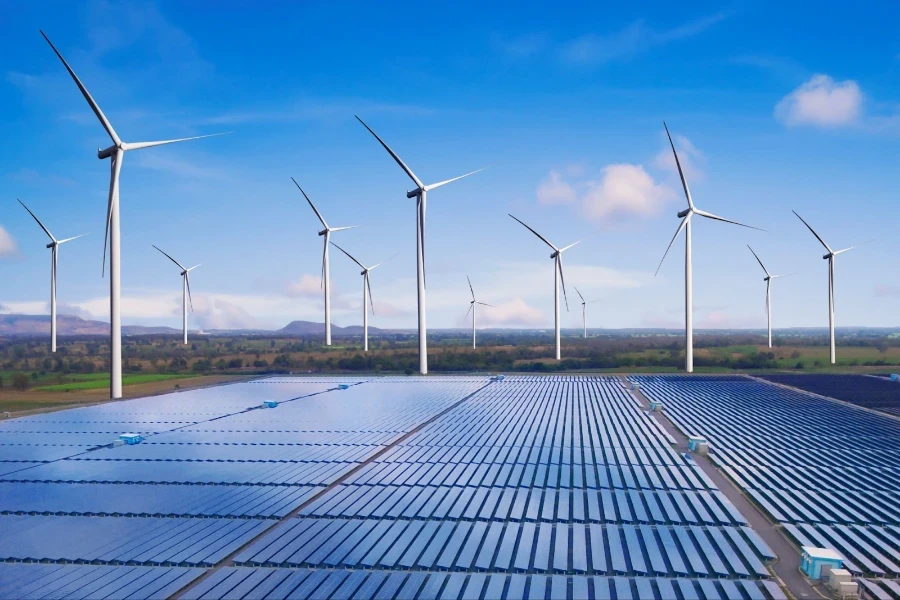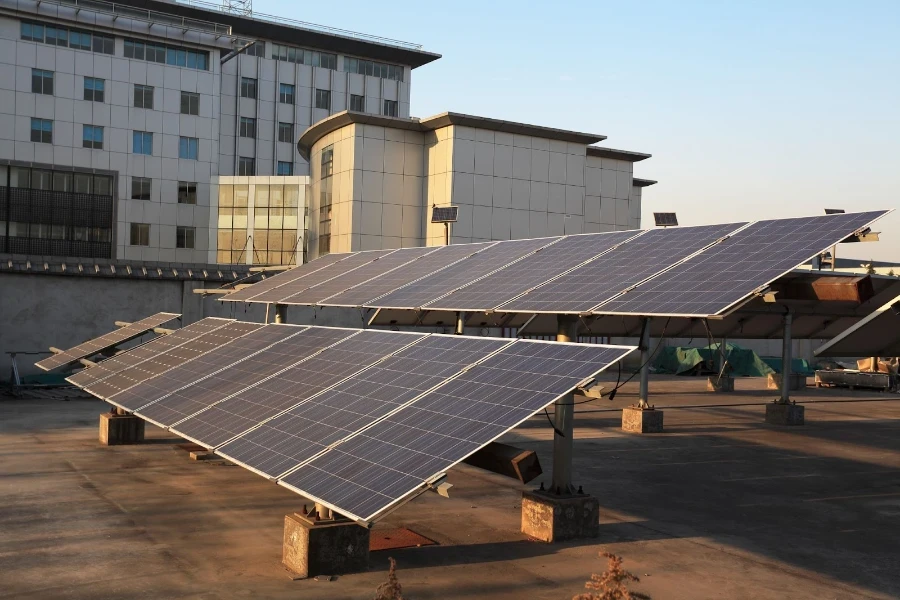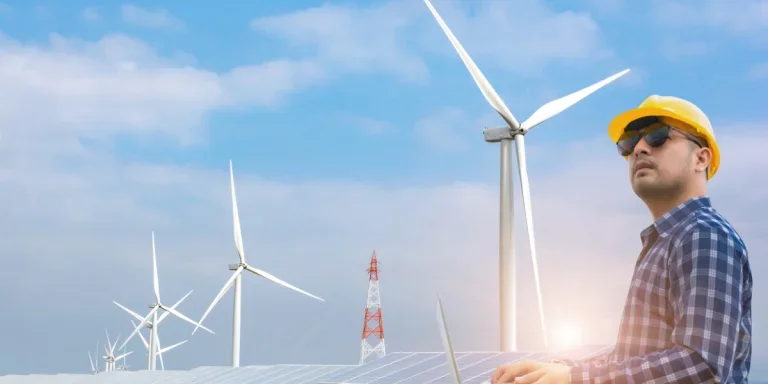Renewable energy is defined as energy that we are able to take directly nature, such as solar and wind power, etc. Renewable energy generators are therefore devices that can allow us to utilize this naturally occurring energy.
Individuals can harness devices such as solar panels and home wind turbines to create their own small power stations and reduce their dependence on external power supplies. Meanwhile, businesses, by installing large-scale solar photovoltaic systems or wind turbines, can significantly reduce their electricity bills.
This article will introduce the basic concepts of renewable energy generators and what factors you should consider before choosing which one is right for your home or business.
Table of Contents
What are renewable energy generators?
Renewable energy generator categorizations
Market size and growth
Solar-powered generators for home and business
Wind-powered generators for home and business
Final words
What are renewable energy generators?

Renewable energy generators, especially solar and wind power systems, utilize the renewable resources found in nature to generate electricity. This process is not only environmentally friendly but also economically viable in the long term.
Solar power systems operate by turning the sun’s rays into an electrical current via photovoltaic (PV) panels made from semiconductor materials (usually silicon). The direct conversion of sunlight into electricity eliminates the need for complex mechanical processes or the production of harmful emissions.
This makes solar power systems particularly suitable for installation on the rooftops of residential and commercial buildings, as well as for off-grid solutions in remote areas and developing countries where access to the traditional power grid may be entirely absent.
Meanwhile, wind power generation relies on wind turbines, whose blades rotate under the force of the wind, thus driving a generator to produce electricity in an extremely ecologically friendly manner.
From vast plains to coastal areas and even offshore wind farms, wind turbines can efficiently convert wind energy into electricity. For example, Denmark, as a pioneering country in wind energy utilization, is able on some days to rely entirely on wind power to meet its domestic electricity needs.
From a financial feasibility perspective, the costs of solar and wind power systems have significantly decreased in recent years thanks to technological advancements and the expansion of production scale. The reduced cost and increased efficiency of solar panels have made solar power an increasingly preferred choice for many households and businesses.
At the same time, government subsidies and incentivizing policies have also made these technologies more attractive. In many countries, investing in solar and wind power systems can not only lead to long-term economic savings through reduced electricity bills but also generate additional income through the sale of surplus electricity back to the grid.
In summary, solar and wind power generators are not only powerful tools to reduce the pains of the global energy crisis but also an increasingly economically viable investment proposal. With ongoing technological advancements and further cost reductions, these renewable energy technologies are expected to play an increasingly important role in the global energy market.
Renewable energy generator categorizations
Among renewable energy generators, solar and wind generators are the two most representative forms. They utilize natural resources to convert sunlight and wind energy into electricity, providing clean energy for a variety of application scenarios. The following focuses on these two types of generators, with a brief description of the other forms.
Solar-powered generators

Principle
Solar power is primarily generated through photovoltaic (PV) systems, the core of which are solar panels. These panels consist of multiple solar cells, each using semiconductor materials (such as silicon) to capture sunlight. When photons (particles of sunlight) hit these semiconductor materials, their atoms release electrons, thus generating an electric current.
Products
Monocrystalline silicon solar panels: Using high-purity silicon, these panels have higher efficiency but are relatively more expensive.
Polycrystalline silicon solar panels: Made using a simpler manufacturing process, making their cost lower, but their efficiency is also slightly lower than that of monocrystalline silicon panels.
Thin-film solar panels: Using amorphous silicon or other materials, these panels can be flexible, making them suitable for irregular surfaces, as well as lower efficiency and lower cost.
Application scenarios and examples
Solar power systems can be applied to residential rooftops, commercial buildings, agricultural facilities, off-grid power supply in remote areas, and large solar power stations.
For example, China’s Longgang Large Solar Power Station is one of the largest solar projects in the world, showcasing the potential of solar energy in large-scale power production.
Wind-powered generators

Principle
Wind power generation relies on wind turbines, which at their core is technology that converts the kinetic energy of wind into electricity. When the wind passes through the turbine’s blades, the blades rotate, driving the generator connected to the blade shaft, thus producing electricity.
Products
Horizontal-axis wind turbines: The most common type of turbine in use currently, with blades fixed on a horizontal shaft at the top of a tower.
Vertical-axis wind turbines: Blades rotate around a vertical axis, making them suitable for areas with variable wind directions.
Application scenarios and examples
Wind turbines are widely used in both onshore and offshore wind farms. Onshore wind farms are usually located in open plains, mountaintops, or other areas with strong winds. Offshore wind farms take advantage of the more stable and stronger winds at sea.
For example, the London Array in the UK is one of the world’s largest offshore wind farms, its massive scale demonstrating the potential of wind energy in providing large-scale clean electricity.
Other renewable energy generators
Although solar and wind energy have achieved significant commercial success, other forms such as hydroelectric, geothermal, and biomass generators also contribute to the energy mix, albeit on a smaller or more geographically limited scale.
Hydroelectric generators: These use water flow to drive turbines, mainly through dams or run-of-the-river systems.
Geothermal generators: These utilize the Earth’s internal heat to produce steam, driving turbines.
Biomass generators: These convert organic materials into electricity, often through combustion or biogas production.
Market size and growth
According to Grandview Research, the global solar photovoltaic panel market reached an estimated worth of USD 170.25 billion in 2023. From 2024 to 2030, this market is expected to grow at a compound annual growth rate (CAGR) of 7.7%, reflecting the increasing maturity of solar technology and market acceptance.
Growth in the solar industry has been particularly significant in the U.S. In the third quarter of 2023, installed solar capacity in the U.S. reached 6.5 gigawatts DC (GWdc), a 35% increase year over year.
This growth has been driven in particular by the implementation of federal clean energy policies, and the U.S. was expected to add 33 gigawatts (GW) of new solar capacity in 2023, further strengthening solar’s position as an integral part of the U.S. energy mix.
The global wind turbine market was valued at USD 53.4 billion in 2020 and is projected to grow at a compound annual growth rate (CAGR) of 6.3% between 2020 and 2030 to reach USD 98.4 billion by 2030, according to a report by Allied Market Research.
This forecast highlights the robust growth potential of the wind turbine market, reflecting the growing global demand and investment in wind energy as a clean, renewable energy source.
Moreover, the cumulative, globally-installed wind energy capacity has reached approximately 906 gigawatts (GW) by 2022, demonstrating the strong momentum of the wind energy market. In that year, 77.6 GW of wind power capacity was added globally, a 9% increase from 2021.
This growth rate is not only a testament to the reliability of wind energy technology, but also reflects the high level of acceptance of wind energy.
Solar-powered generators for home and business

Solar generators can be valuable to homes and businesses in a variety of ways. For example, their capacity to convert solar energy into electricity provides homes and businesses with a source of power independent of traditional grids, meaning that they can continue to supply power in the event of grid instability or disruption, safeguarding homes and production from disruption.
In addition, by reducing their dependence on the grid, individuals and businesses can significantly reduce their electricity bills. In some cases, if a solar generator produces more electricity than it needs, it can also sell the excess to the grid, generating additional revenue.
Overall, solar-powered generators offer a cost-effective, energy self-sufficient solution for homes and businesses.
Solar power selection guide
When choosing a solar generator (mainly solar panels), there are several key factors that should be considered to ensure that the most suitable product is chosen:
Type
Monocrystalline solar panels: Suitable for scenarios that require high efficiency and durability, such as residential rooftops and commercial buildings. They offer the highest power output for the same size, but are relatively costly.
Polycrystalline solar panels: Cost less but are slightly less efficient. Suitable for scenarios with limited budget and large available space, such as some large commercial or agricultural applications.
Thin-film solar panels: Flexible and lightweight, suitable for non-load-bearing roofs, portable, or temporary installation scenarios. Less efficient and require more surface area.
Weather resistance
Depending on the climatic conditions of the installation site (e.g., high temperatures, high humidity, wind and snow burdens, etc.), choose solar panels that have the appropriate weather resistance. Some solar panels are specifically designed to operate in extreme climatic conditions.
Brand
Choose a reputable brand and pay attention to product quality assurance and after-sales service. Long-term guarantees can provide better investment protection.
Installation space
Consider the size and shape of your installation space and choose the type and layout of solar panels that best suits that space.
Financial viability
The financial viability of solar-powered Generators involves several aspects, including initial installation cost, system size, electricity price, operation and maintenance costs, and system lifespan. Here are two simple examples to help you evaluate the viability of solar generators for home and commercial use.
| Parameter | Small residential (average) | Commercial project (average) |
| Initial installation cost | USD 5,500 | USD 55,000 |
| System size | 5 kW | 50 kW |
| Annual power generation | 7,000 kWh | 70,000 kWh |
| Average electricity price | USD 0.17/kWh | USD 0.13/kWh |
| Operation and maintenance costs | USD 50/year | USD 500/year |
| System lifespan | 25 years | 25 years |
| Annual electricity cost savings | USD 1,190 | USD 9,100 |
| Total electricity cost savings over 25 years | USD 29,750 | USD 22,7500 |
| Total savings | USD 28,500 | USD 215,000 |
Wind-powered generators for home and business

Wind turbines provide homes and businesses with a different renewable energy option from solar generators by utilizing wind power to generate electricity. Unlike solar power, which relies on the intensity of sunlight, wind power has the advantage of being able to generate electricity at night or in cloudy weather.
This provides greater flexibility in situations where a continuous supply of electricity is required. For homes, wind turbines are particularly effective in areas where wind energy is abundant, lowering electricity bills and providing a steady source of backup power.
For businesses, wind power can significantly reduce operating costs and generate revenue from selling electricity to the grid, especially in large wind power projects. While the initial installation and maintenance costs of wind turbines may be higher than those of solar power systems, the long-term economic benefits are significant given the right geographic location and wind conditions.
Wind generator selection guide
When selecting a wind turbine, the following key factors should be considered to ensure that the system you purchase is best suited to your needs:
Wind speed
The average wind speed of a geographic location is the most important factor in determining the efficiency of wind power generation. Typically, an average wind speed of at least 4.5 meters per second (10 mph) is required to operate a wind turbine economically and efficiently.
Tower height
The height of a wind turbine affects the wind speed to which it is exposed. In general, the taller the tower, the higher the wind speed and the more efficient the power generation. Consider the optimal height to install your tower to maximize wind energy capture.
Power generation
Choose the right size wind turbine for your energy needs. Consider the average power consumption of your home or business and choose a generator that will meet that need.
Size and type
Home use: Smaller wind turbines are suitable for home use and can be installed on the roof or at ground level.
Commercial: Larger systems are suitable for business or farm use and require more space and a higher initial investment.
Local regulations
Before shopping around, find out about local ordinances, building standards, and whether special permits are required. Some areas have strict restrictions on the height and location of wind turbines.
Maintenance
When choosing a brand and model, consider its historical performance, reliability, and maintenance needs. Understand the warranty and service support offered by the manufacturer.
Financial viability
The financial viability of wind-powered generators also involves a number of factors, which will be discussed below using two brief examples.
| Parameter | Small residential (average) | Commercial project (average) |
| Average wind speed requirement | At least 4.5 m/s | At least 4.5 m/s, larger systems may require higher |
| Initial installation cost | USD 5,000 | USD 3,000,000 |
| System Size | 5kW | 3 MW |
| Capacity factor | 20%(10~30%) | 35%(20~50%) |
| Annual electricity production | 8000 kWh | 8.4 million kWh |
| Average electricity price | USD 0.17/kWh | USD 0.13/kWh |
| Annual maintenance cost | USD 0-200 | USD 20,000 |
| Annual electricity cost savings | USD 1300 | USD 1090 |
| System lifespan | 20 years | 20-25 years |
| Electricity sale potential | Depends on local grid policies | Greater potential, especially for large projects |
Final words
In the background of the current energy crisis, the shift to renewable energy sources such as solar and wind has become a key action for both individuals and businesses to reduce their environmental impacts, make economic savings, and promote sustainable development.
For individuals, the utilization of renewable energy not only reduces long-term electricity bills but also provides energy independence. It also helps businesses reduce operating costs, enhance their brand image, and respond to increasingly stringent environmental regulations.
As technology advances and costs fall, it is expected that the use of renewable energy will become more widespread and the application of related energy utilization devices will become more developed.
Finally, if you are interested in purchasing renewable energy generators, such as solar panels or wind turbines for your home or business, visit Alibaba.com for a wealth of cutting-edge options.




